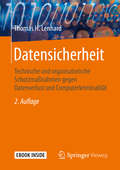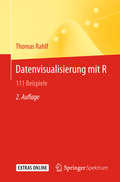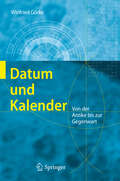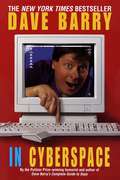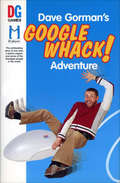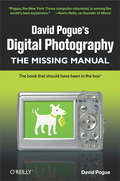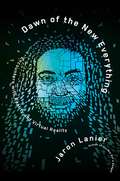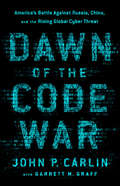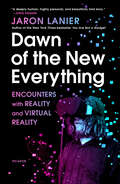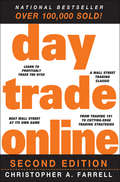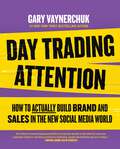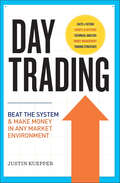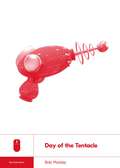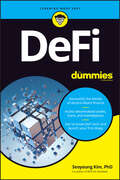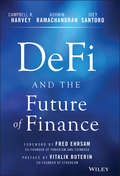- Table View
- List View
Datenschutz: Einführung in technischen Datenschutz, Datenschutzrecht und angewandte Kryptographie
by Ronald Petrlic Christoph Sorge Wolfgang ZiebarthDieses Lehrbuch behandelt im ersten Teil schwerpunktmäßig technische Maßnahmen, die den Schutz personenbezogener Daten sicherstellen. Dazu werden grundlegende Verfahren der Anonymisierung und der Gewährleistung von Anonymität im Internet (z. B. Tor) vorgestellt. Das Buch gibt einen Überblick über gängige Verfahren des Identitätsmanagements (z. B. OpenID Connect) und die in elektronischen Ausweisdokumenten (z. B. im Personalausweis) verwendeten Sicherheitsmaßnahmen. Die Datenschutz-Garantien der vermittelten Ansätze werden im Detail behandelt. Im Bereich des World Wide Web erfährt der Leser, wo die Probleme aus Sicht des Datenschutzes liegen und wie diese Lücken geschlossen werden können. Anonyme Bezahlverfahren und eine Untersuchung von Bitcoin runden den technischen Teil des Buches ab. Der Leser lernt Ansätze aus der Praxis kennen, um so je nach Anforderungen in der Systementwicklung das passende Verfahren auswählen zu können.Im zweiten Teil werden die Grundlagen des Datenschutzrechts behandelt. Denn technische Maßnahmen sollen unerlaubte Datenverarbeitung verhindern; das Recht bestimmt, welche Datenverarbeitungen erlaubt sind. Ohne Kenntnisse im Datenschutzrecht können technische Maßnahmen nicht richtig implementiert werden. Zum besseren Verständnis erfolgt ein Überblick über die Rechtsordnung insgesamt, in die das Datenschutzrecht eingeordnet wird. Betrachtet werden die europäische und die verfassungsrechtliche Dimension des Datenschutzes. Der Schwerpunkt liegt auf den Regelungen der Datenschutz-Grundverordnung. Dabei werden auch besonders häufig vorkommende und Fragen aufwerfende Verarbeitungssituationen wie das Webtracking erörtert. Beispielhaft werden datenschutzrechtliche Fälle bearbeitet.
Datenschutzaufsicht nach der EU-Datenschutz-Grundverordnung: Neue Aufgaben und Befugnisse der Aufsichtsbehörden (DuD-Fachbeiträge)
by Alexander RoßnagelDas Buch enthält ein Rechtsgutachten, das im Auftrag der unabhängigen Datenschutzbehörden der Länder verfasst wurde. Es erläutert die durch die EU-Datenschutz-Grundverordnung veränderten Aufgaben und Befugnisse der Aufsichtsbehörden und ihre neue Verantwortung für den Grundrechtsschutz in der digitalen Welt. Um den Datenschutz in der Europäischen Union besser durchzusetzen und seine Anwendung zu harmonisieren, enthält die Datenschutz-Grundverordnung zahlreiche neue Instrumente, Institutionen und Verfahren. Diese beeinflussen die Aufgaben und Befugnisse der Aufsichtsbehörden, den Handlungsrahmen der Verantwortlichen und die Zusammenarbeit zwischen den Akteuren.
Datensicherheit: Technische und organisatorische Schutzmaßnahmen gegen Datenverlust und Computerkriminalität
by Thomas H. LenhardAnhand vieler Praxisbeispiele und Merks#65533;tze bietet das Buch einen leicht verst#65533;ndlichen Einstieg in die technische und organisatorische Datensicherheit. Es liefert einen Einblick in das f#65533;r Datenschutzbeauftragte obligatorische technische Wissen. Datensicherheit ist ein untrennbarer Teil des Datenschutzes, der mehr und mehr in unserer Gesellschaft an Bedeutung gewinnt. Er kann nur dann wirksam umgesetzt werden, wenn ein Verst#65533;ndnis f#65533;r technische Zusammenh#65533;nge und Gef#65533;hrdungen gegeben ist. Dabei erstreckt sich die Datensicherheit auf weit mehr Informationen als nur auf Daten mit Personenbezug. Sie sichert s#65533;mtliche Daten und damit den Fortbestand von Unternehmen und Organisationen.
Datensicherheit: Technische und organisatorische Schutzmaßnahmen gegen Datenverlust und Computerkriminalität
by Thomas H. LenhardAnhand vieler Praxisbeispiele und Merksätze bietet das Buch einen leicht verständlichen Einstieg in die technische und organisatorische Datensicherheit. Es liefert einen Einblick in das für Datenschutzbeauftragte obligatorische technische Wissen. Datensicherheit ist ein untrennbarer Teil des Datenschutzes, der mehr und mehr in unserer Gesellschaft an Bedeutung gewinnt. Er kann nur dann wirksam umgesetzt werden, wenn ein Verständnis für technische Zusammenhänge und Gefährdungen gegeben ist. Dabei erstreckt sich die Datensicherheit auf weit mehr Informationen als nur auf Daten mit Personenbezug. Sie sichert sämtliche Daten und damit den Fortbestand von Unternehmen und Organisationen.
Datensicherheit: Technische und organisatorische Schutzmaßnahmen gegen Datenverlust und Computerkriminalität
by Thomas H. LenhardDie 3. Auflage des Buches bietet eine leicht verständliche Einführung in die technische und organisatorische Datensicherheit anhand vieler praktischer Beispiele und Stichpunkte. Es liefert einen Einblick in das für Datenschutzbeauftragte obligatorische technische Wissen. Datensicherheit ist ein untrennbarer Teil des Datenschutzes, der mehr und mehr in unserer Gesellschaft an Bedeutung gewinnt. Er kann nur dann wirksam umgesetzt werden, wenn ein Verständnis für technische Zusammenhänge und Gefährdungen gegeben ist. Dabei erstreckt sich die Datensicherheit auf weit mehr Informationen als nur auf Daten mit Personenbezug. Sie sichert sämtliche Daten und damit den Fortbestand von Unternehmen und Organisationen.
Datensicherung als Teil der IT- und Cybersecurity: Technische, menschliche und betrügerische Risiken erkennen und mit umfassenden Backup- und IT-Sicherheitsstrategien minimieren
by Patrick Müller Vanessa Chamera Martin BodensteinDieses Buch bietet eine umfassende Einführung in die Welt der Datensicherung und führt durch die essenziellen Bereiche – von Bedrohungen bis hin zu praktischen Schutzstrategien. Die digitale Ära macht Daten zum Rückgrat und Wettbewerbsvorteil von Unternehmen, wobei Datenverluste erhebliche Schäden verursachen können. Es gibt unterschiedliche Risikokategorien für Datenverluste, darunter technische und betriebliche Gefahren. Dieses Buch umfasst Maßnahmen, die die IT-Systeme vor Ausfällen und unberechtigtem Zugriff schützen und die Wesentlichkeit der Datensicherung aufzeigen. Dabei werden präventive, detektierende und reaktive Schutzmaßnahmen berücksichtigt und eine individuelle und risikobasierte Strategie aufgezeigt. Das Buch bietet praktische Hinweise, darunter Checklisten und Vorlagen, die online verfügbar sind. Es dient als Leitfaden für Unternehmen, um ihre Daten effektiv sowie effizient zu schützen, die IT- und Cybersecurity zu erhöhen und den Wert ihrer Daten risikobasiert zu würdigen.
Datenvisualisierung mit R: 111 Beispiele
by Thomas RahlfDieses Buch f#65533;hrt in die Grundlagen der Gestaltung von Pr#65533;sentationsgrafiken mit der Open Source Software R ein, die hinsichtlich der Visualisierungsm#65533;glichkeiten praktisch keine W#65533;nsche offen l#65533;sst und sich zunehmend als Standard im Bereich der Statistiksoftware etabliert. Anhand von 111 vollst#65533;ndigen Skript-Beispielen lernen Sie, wie Sie Balken- und S#65533;ulendiagramme, Bev#65533;lkerungspyramiden, Lorenzkurven, Streudiagramme, Zeitreihendarstellungen, Radialpolygone, Gantt-Diagramme, Profildiagramme, Heatmaps, Bumpcharts, Mosaik- und Ballonplots sowie eine Reihe verschiedener thematischer Kartentypen mit dem Base Graphics System von R erstellen. F#65533;r jedes Beispiel werden reale Daten verwendet sowie die Abbildung und deren Programmierung Schritt f#65533;r Schritt erl#65533;utert. Das Buch ist damit ein wertvolles Nachschlagewerk f#65533;r eine F#65533;lle von Anwendungsf#65533;llen der Datenvisualisierung, zu deren traditionellen Anwendungsbereichen in Wissenschaft und Marketing vermehrt auch neue Gebiete wie Big- Data-Analysen oder Datenjournalismus hinzukommen. In der vorliegenden Auflage wurden Beispiele zu Cartogrammen, Chord-Diagrammen und Netzwerken sowie ein neues Kapitel zu interaktiven Visualisierungen mit Javascript aufgenommen. Der Autor Thomas Rahlf arbeitet als Direktor in der Gruppe Qualit#65533;ts- und Verfahrensmanagement bei der Deutschen Forschungsgemeinschaft und ist Lehrbeauftragter an der Universit#65533;t Bonn. Er hat #65533;ber Methodologien der Statistik und #65533;konometrie promoviert, ist Mitglied im Editorial Board der Zeitschrift Cliometrica und Herausgeber einer Historischen Statistik von Deutschland. Den Themen Open Source, Datendesign und -visualisierung gilt seit vielen Jahren sein Interesse.
Datenvisualisierungen mit Julia: Erstellen von Grafiken, interaktiver Oberflächen sowie Animationen
by Daniel JaudDieses Buch stellt eine Einführung in das Programmieren und das Erstellen publikationsfertiger Grafiken oder interaktiver Animationen mit der Julia-Programmiersprache dar. Ein besonderes Augenmerk liegt dabei auf einer schrittweise Auseinandersetzung mit den verschiedenen Plot-Möglichkeiten. Im Buch werden aufeinander aufbauend alle wichtigen Programmierkonstrukte zum Erstellen von Grafiken ausgearbeitet. Durch zusätzliche Aufgaben mit Beispiellösungen kann der Leser sein gelerntes Wissen nochmals selbst in der Praxis anwenden.Der InhaltErste SchritteSchleifen in JuliaErstellen einfacher GrafikenDarstellungsoptionen von Plots und Schleifen mit FunktionenVektorfelder, 3d-Plots, Oberflächen und KonturenInteraktive Anwendungen und AnimationenDer AutorDr. Daniel Jaud studierte Mathematik und Physik mit anschließender Promotion. Er unterrichtet an einem Gymnasium und ist weiterhin als freier Wissenschaftler im Bereich der mathematischen Physik tätig.
Datenwirtschaft und Datentechnologie: Wie aus Daten Wert entsteht
by Marieke Rohde Matthias Bürger Kristina Peneva Johannes MockIn diesem Open-Access-Buch stehen die wirtschaftliche Verwertung von Daten und die dazu gehörenden technischen und organisatorischen Prozesse und Strukturen in Unternehmen im Fokus. Es behandelt Themen wie Datenmonetarisierung, Datenverträge, Data Governance, Informationssicherheit, Datenschutz und die Vertrauenswürdigkeit von Daten.Seit Jahren wird davon gesprochen, dass „Daten das neue Öl“ sind. Expertinnen und Experten sind sich einig: Das Wertschöpfungspotential von Daten ist enorm und das über fast alle Branchen und Geschäftsfelder hinweg. Und dennoch bleibt ein Großteil dieses Potentials ungehoben. Deshalb nimmt dieser Sammelband konkrete Innovationshemmnisse, die bei der Erschließung des wirtschaftlichen Werts von Daten auftreten können, in den Blick. Er bietet praktische Lösungsansätze für diese Hürden an den Schnittstellen von Ökonomie, Recht, Akzeptanz und Technik. Dazu folgen die Autorinnen und Autoren einem interdisziplinären Ansatz und greifen aktuelle Diskussionen aus der Wissenschaft auf, adressieren praxisnahe Herausforderungen und geben branchenunabhängige Handlungsempfehlungen. Den Leserinnen und Lesern soll eine transparente Informationsbasis angeboten werden und damit die Teilnahme an der Datenwirtschaft erleichtert werden. Dieses Buch richtet sich an Entscheidungsträgerinnen und Entscheidungsträger in Unternehmen sowie an Entwicklerinnen und Entwickler datenbasierter Dienste und Produkte. Der Band ist ebenfalls für Fachkräfte der angewandten Forschung wie auch für interdisziplinär Studierende z.B. der Wirtschaftsinformatik, der technikorientierten Rechtswissenschaft oder der Techniksoziologie relevant.
Datum und Kalender: Von der Antike bis zur Gegenwart
by Winfried GörkeNach einer Einführung in das Kalenderwesen erläutert der Autor Alternativen zum gregorianischen Kalender. Er präsentiert verschiedene Kalendersysteme wie den europäischen, den japanischen, chinesischen und den jüdischen Kalender und erläutert anhand der Oster-Berechnung die Methoden der Informatik, die für die Festlegung kalenderabhängiger Festtage von Bedeutung sind. Darüber hinaus stellt er eine Reihe von Vorschlägen zur Verbesserung von Kalendern vor.
Dave Barry in Cyberspace
by Dave Barry"RELENTLESSLY FUNNY . . . BARRY SHINES." --People. A self-professed computer geek who actually does Windows 95, bestselling humorist Dave Barry takes us on a hilarious hard drive via the information superhighway--and into the very heart of cyberspace, asking the provocative question: If God had wanted us to be concise, why give us so many fonts? Inside you'll find juicy bytes on How to Buy and Set Up a Computer; Step One: Get Valium Nerdstock in the Desert; Or: Bill Gates Is Elvis Software: Making Your Computer Come Alive So It Can Attack You Word Processing: How to Press an Enormous Number of Keys Without Ever Actually Writing Anything Selected Web Sites, including Cursing in Swedish, Deformed Frog Pictures, and The Toilets of Melbourne, Australia And much, much more! "VERY FUNNY ... After a day spent staring at a computer monitor, think of the book as a kind of screen saver for your brain." --New York Times Book Review
Dave Gorman's Googlewhack! Adventure
by Dave GormanA “hilarious” tale of procrastination, obsession, search engines, and worldwide travel, based on the award-winning one-man comedy show (Booklist). “When he turned 31, British stand-up comic Gorman decided he wanted to be taken seriously, so he landed a contract to write a novel. He took novel writing so seriously he grew a beard. But no matter how he tried, Gorman couldn’t actually write anything. One of his procrastination methods was googlewhacking—a game in which the ‘whacker’ types two different words into Google and tries to get exactly one hit. His first googlewhack, ‘Dork Turnspit,’ led him to a site featuring photographs of women with dogs. Gorman found the site so fascinating that he met its owner and then asked the women-and-dogs fellow to find him another googlewhack. And so begins one of history’s greatest ventures in procrastination. Over the next weeks, Gorman traveled tens of thousands of miles, everywhere from Columbus, Ohio, to Beijing, China, meeting googlewhacks, trying to string together 10 in a row by getting two new googlewhacks from each person he met . . . Gorman’s self-deprecating wit and irrational dedication to his quest make this a hilarious travelogue.” —Booklist “Fresh, funny and entertaining.” —The Daily Mail “An onslaught of amusing anecdotes and digressive detours.” —Publishers Weekly
David Karp: The Mastermind behind Tumblr (Gateway Biographies Ser.)
by Karen Latchana KenneyWhat's more popular than Tumblr? This microblogging site has taken the Web by storm since its founding in 2007. Not much can top it when it comes to capturing its fans' imaginations, except for perhaps its creator, David Karp. Karp developed Tumblr after he tried to start a blog and found the process daunting. With most platforms, a blogger faces a huge, empty text box that begs to be filled with words. It was intimidating for a guy who'd never blogged before. Karp had the idea for tumblelogging—creating short blog posts—and built Tumblr as a platform. It lets users easily post both text and images, making Tumblr highly visual and expressive. Creating a different way to blog came naturally to Karp, who never does things by the book. At fifteen, he dropped out of school. At seventeen, he moved to Tokyo, holing up with a computer and fine-tuning his tech skills. He returned to the states to build a business—but to do that, he stretched the truth. He used a deep voice on the phone with potential clients so they wouldn't guess how young he was. He didn't tell anyone how little experience he had. Yet people could see he had a good thing going with Tumblr. The company quickly found support and grew into what it is today: a groundbreaking site for connection and creation. And as the mastermind behind it, Karp is sure to remain a figure to watch.
David Pogue's Digital Photography: The Missing Manual (Missing Manual)
by David PogueIf you're ready to jump into digital photography or would like to increase the skills you already have, David Pogue's Digital Photography: The Missing Manual is just what you need. Bestselling author David Pogue provides a no-nonsense guide to the entire process, including how to: buy and use a digital camera; get the same photographic effects as the pros; manage the results on your Mac or PC; edit photos; and, finally, share the results with your adoring fans -- on paper, online, or on mugs, jigsaw puzzles, and blankets. After reviewing hundreds of digital cameras and photo services in his weekly New York Times column, David Pogue knows digital photography. With this new Missing Manual you will:Get expert advice on how to choose a digital camera, including information on the only specs that matter. (Hint: it's not about megapixels). Learn the basics of lighting, composition, and shooting lots of photos Understand how to choose the best camera settings for 20 different scenarios Unravel the problems of correcting images and storing them Learn David's tips and tricks for sharing and printing images Get a special troubleshooting section you can turn to when things go wrong David Pogue's witty, authoritative voice has demystified the Mac, Windows, iPods and iPhones for millions of readers. Now, he offers step-by-step instructions and plenty of friendly advice to help you join in the fun and get real satisfaction from digital photography.
David Taylor's Inside Track: Provocative Insights into the World of IT in Business (Computer Weekly Professional Ser.)
by David TaylorNever before has IT played such a significant role in transforming organisations, of all sizes. And yet it continues to be dominated by technical jargon, acronyms and irrelevant detail. This book cuts through all of the confusion, and presents a clear, direct, solution based focus on the key IT/business issues facing every company and business leader today.This book contains the complete, first fifteen months of David Taylor's highly acclaimed Computer Weekly column - Inside Track. With a reputation for cutting through the hype, David focuses on the IT/business and personal leadership agenda, covering such issues as:* The key IT issues for the boardroom - in business language* Actions to win in the new world of e-commerce - and get started today* The successful new IT leader - the skills you and your company need toemploy* Quick solutions to long-term IT problems - they can be resolved* How to motivate your people, and slash staff turnover - save a fortune onrecruitment costs* True IT/business alignment - add real value to your bottom lineDavid Taylor is a leading authority on IT in business. He is President of the association of IT Directors, Certus, a reference partner to the UK Government's National Audit Office, and a registered expert with several global research companies. His overall aim is to enable people and organisations to be all that they can be, through the combination of world class technology, true leadership and the release of human potential. With a prestigious background across companies such as Rolls-Royce, Allianz and Cornhill, David has a driving, positive passion for IT in business, and a reputation for championing IT Directors who want to achieve board level positions in their organisations. David and his team work with FTSE 200 companies on winning in the new internet economy, with entrepreneurs starting new dot com ventures, and with CEOs, advising on the qualities they should seek in their IT leaders. A regular writer, television presenter and speaker, David gives keynote, leadership and IT presentations throughout the world. He lives with his wife, Rosalind and their two children, Anthony and Olivia, in Surrey.
Dawn Of The New Everything: Encounters With Reality And Virtual Reality
by Jaron LanierBridging the gap between tech mania and the experience of being inside the human body, Dawn of the New Everything is a look at what it means to be human at a moment of unprecedented technological possibility. <p><p> Through a fascinating look back over his life in technology, Jaron Lanier, an interdisciplinary scientist and father of the term “virtual reality,” exposes VR’s ability to illuminate and amplify our understanding of our species, and gives readers a new perspective on how the brain and body connect to the world. An inventive blend of autobiography, science writing, philosophy and advice, this book tells the wild story of his personal and professional life as a scientist, from his childhood in the UFO territory of New Mexico, to the loss of his mother, the founding of the first start-up, and finally becoming a world-renowned technological guru. <p> Understanding virtual reality as being both a scientific and cultural adventure, Lanier demonstrates it to be a humanistic setting for technology. While his previous books offered a more critical view of social media and other manifestations of technology, in this book he argues that virtual reality can actually make our lives richer and fuller.
Dawn of the Code War: America's Battle Against Russia, China, and the Rising Global Cyber Threat
by Garrett M. Graff John P. CarlinThe inside story of how America's enemies launched a cyber war against us-and how we've learned to fight back With each passing year, the internet-linked attacks on America's interests have grown in both frequency and severity. Overmatched by our military, countries like North Korea, China, Iran, and Russia have found us vulnerable in cyberspace. The "Code War" is upon us. In this dramatic book, former Assistant Attorney General John P. Carlin takes readers to the front lines of a global but little-understood fight as the Justice Department and the FBI chases down hackers, online terrorist recruiters, and spies. Today, as our entire economy goes digital, from banking to manufacturing to transportation, the potential targets for our enemies multiply. This firsthand account is both a remarkable untold story and a warning of dangers yet to come.
Dawn of the New Everything: Encounters with Reality and Virtual Reality
by Jaron LanierNamed one of the best books of 2017 by The Economist, The Wall Street Journal, & VoxThe father of virtual reality explains its dazzling possibilities by reflecting on his own lifelong relationship with technologyBridging the gap between tech mania and the experience of being inside the human body, Dawn of the New Everything is a look at what it means to be human at a moment of unprecedented technological possibility. Through a fascinating look back over his life in technology, Jaron Lanier, an interdisciplinary scientist and father of the term “virtual reality,” exposes VR’s ability to illuminate and amplify our understanding of our species, and gives readers a new perspective on how the brain and body connect to the world. An inventive blend of autobiography, science writing, philosophy and advice, this book tells the wild story of his personal and professional life as a scientist, from his childhood in the UFO territory of New Mexico, to the loss of his mother, the founding of the first start-up, and finally becoming a world-renowned technological guru.Understanding virtual reality as being both a scientific and cultural adventure, Lanier demonstrates it to be a humanistic setting for technology. While his previous books offered a more critical view of social media and other manifestations of technology, in this book he argues that virtual reality can actually make our lives richer and fuller.
Day Trade Online
by Farrell Christopher A.Day trading can be quite lucrative, but only if you know what you are doing. As Farrell points out: "Trading for a living is hard. Trading for a living over the Internet is even harder. There are many challenges and obstacles that confront you. Venturing into this jungle unprepared is a recipe for disaster. " This straightforward guide provides the head start and heads up necessary to thrive as a day trader, covering everything from the dangers and pitfalls of trading online to an in-depth analysis of which trading techniques work and which don't. Day Trade Online, Second Edition presents inside information on the strategies of top trading firms, including the most secretive, misunderstood, and profitable function on Wall Street. Most importantly, you will learn to look at ten different stocks and pinpoint which one to trade, when, at what price, and why. With the right know-how, you will be able to apply this knowledge to every single stock that you screen.
Day Trading Attention: How to Actually Build Brand and Sales in the New Social Media World
by Gary Vaynerchuk“One thing I've learned being around Gary for the last decade is that when he sees new consumer trends or new best practices in marketing, people should listen and act on them.” — Michael Rubin, CEO of Fanatics In his seventh business book, bestselling author, entrepreneur, and investor Gary Vaynerchuk offers fresh, in-depth advice to enhance brand development, grow sales, and beat the competition using modern advertising strategies grounded in social media.In his 2013 bestseller Jab, Jab, Jab, Right Hook, Gary Vaynerchuk showed the world how to create winning content for underpriced attention channels. But since then, new platforms have emerged, others have become less relevant, and algorithms are incentivizing new styles of content. New skills are necessary to create advertising that builds brand and sales.In his latest book, Vaynerchuk argues that today’s fast-growing businesses, brands, content creators, and influencers have one thing in common: They mastered storytelling in areas of underpriced attention, which predominantly exists across a handful of social media platforms. Informed by 20+ years of business and marketing success, he contends that the biggest transformation and opportunity is the “TikTokification of Social Media.” Increasingly, platforms are distributing content based on what users are interested in, rather than who they follow. In Day Trading Attention, Gary offers detailed advice on how small businesses, large corporations, and creators can:Understand attention—what it is, where it is, where it’s underpriced, and how to leverage itProduce relevant, strategic content Use modern advertising platforms to build brand and grow sales in today’s rapidly changing environment
Day Trading Stocks The Wall Street Way: A Proprietary Method For Intra-day And Swing Trading
by Josh DiPietroDay Trading Stocks the Wall Street Way: A Proprietary Disclosure on Intra-Day Trading and Swing Trading Equities provides a real-world guide to successful day trading, and gives you the tools, techniques, and tested, reliable methods you need to trade like the pros. Written by a seventeen-year day trading veteran, this guide talks you down from the industry hype to give you a realistic grounding in self-discipline, consistency, and patience while teaching you the hard skills you need to have a real chance of success. <p><p> Avoid losses by swerving from the typical beginner's path of seminars, software, and major brokerage houses, and instead develop the insights that lead to real, long-term profits. With an engaging and humorous tone, the author relates his own experiences and lessons learned to teach you the do's, the don'ts, and the ingredients for success. You'll discover Josh DiPietro's FUSION TRADING SYSTEM—a proven method developed from years of reliability testing. He'll show you how intra-day setups and swing trading setups can be merged to develop a perfect trade. <p> The surest path to failure and tremendous financial loss begins with the over-eager, overly optimistic amateur trader who sees day trading as a quick and easy path to wealth. This book gives you a much more realistic outlook, and the fundamentals you need to make the most of the market. <p> A poorly defined trading approach will cost you more money than you will make, rendering your day trading venture a potentially damaging net loss. Day Trading Stocks the Wall Street Way: A Proprietary Disclosure on Intra-Day Trading and Swing Trading Equities teaches you the avoidance of loss, the discipline, and the transparent strategies of success, so you can play the market to win.
Day Trading: Beat the System and Make Money in Any Market Environment
by Justin KuepperAll You'll Ever Need to Trade from Home When most people hear the term "day trader," they imagine the stock market floor packed with people yelling 'Buy' and 'Sell' - or someone who went for broke and ended up just that. These days, investing isn't just for the brilliant or the desperate—it's a smart and necessary move to ensure financial wellbeing. To the newcomer, day trading can be a confusing process: where do you begin, and how can you approach trading in a careful yet effective way? With Day Trading you'll get the basics, then: Learn the Truth About Trading Understand The Psychology of Trading Master Charting and Pattern-recognition Study Trading Options Establish Trading Strategies & Money Management Day Trading will let you make the most out of the free market from the comfort of your own computer.
Day of the Tentacle (Boss Fight Books)
by Bob MackeySix years after helping the Edison family defeat the designs of a malevolent meteor in Maniac Mansion, college student and classic nerd Bernard Bernoulli once again finds himself at the front door of the infamous mansion. With two weird friends, Hoagie and Laverne, Bernard must stop the evil Purple Tentacle from conquering the world—by freezing hamsters, pushing old ladies down the stairs, abusing Swiss bank accounts, and ever so slightly changing some of the most significant moments in American history. Dave Grossman and Tim Schafer&’s 1993 time-trotting point-and-click adventure game Day of the Tentacle brought LucasArts' game design to a new standard of excellence with smart puzzles, hilarious characters, and an animation style that harkened back to classic Warner Bros. cartoons. And somehow, they fit it all on a fat stack of floppy disks! In this definitive oral history as told by the game&’s designers, musicians, and artists, writer Bob Mackey tells the inside story of Day of the Tentacle&’s lightning-in-a-bottle production, and reveals how two first-time directors boiled down the lessons of past adventure games into a tight and satisfying experience, how their team grappled with evolving technology to achieve the coveted status of multimedia at the dawn of the CD-ROM age, and how a remastered edition brought Tentacle to a new generation of fans.
DeFi For Dummies
by Seoyoung KimGet to know the building blocks of a new economy The promise of decentralized finance (DeFi for those up on their financial lingo) as a disruptor to financial institutions makes it must-know for anyone involved in finance. DeFi For Dummies provides an easy-to-understand option for unraveling the past, present, and future of DeFi. Understand current DeFi applications, including how to build basic applications on the leading platforms, and get a look into the future&’s most promising new DeFi solutions. Staying ahead of the game is critical for finance professionals these days, and this Dummies guide makes it possible, with full coverage of how DeFi affects asset management, lending and borrowing, and investment markets. Wrap your mind around DeFi and start getting hands on, the Dummies way. Learn how the DeFi revolution started and where it&’s going Get insight into opportunities for getting started and building value with DeFi Discover the leading assets, exchanges, and marketplaces built on DeFi principles Create secure DeFi applications on established platformsThis book is great for current pros or active investors in the world of finance who need to get up to speed on the world of DeFi as quickly and clearly as possible.
DeFi and the Future of Finance
by Campbell R. Harvey Ashwin Ramachandran Joey SantoroDuring the Global Financial Crisis in 2008, our financial infrastructure failed. Governments bailed out the very institutions that let the economy down. This episode spurred a serious rethink of our financial system. Does it make any sense that it takes two days to settle a stock transaction? Why do retailers, operating on razor thin margins, have to pay 3% for every customer credit card swipe? Why does it take two days to transfer money from a bank account to a brokerage—or any other company? Why are savings rates miniscule or negative? Why is it so difficult for entrepreneurs to get financing at traditional banks? In DeFi and the Future of Finance, Campbell R. Harvey, Ashwin Ramachandran and Joey Santoro, introduce the new world of Decentralized Finance. The book argues that the current financial landscape is ripe for disruption and we are seeing, in real time, the reinvention of finance. The authors provide the reader with a clear assessment of the problems with the current financial system and how DeFi solves many of these problems. The essence of DeFi is that we interact with peers—there is no brick and mortar and all of the associated costs. Savings and lending are reinvented. Trading takes place with algorithms far removed from traditional brokerages. The book conducts a deep dive on some of the most innovative protocols such as Uniswap and Compound. Many of the companies featured in the book you might not have heard of—however, you will in the future. As with any new technology, there are a myriad of risks and the authors carefully catalogue these risks and assess which ones can be successfully mitigated. Ideally suited for people working in any part of the finance industry as well as financial policy makers, DeFi and the Future of Finance gives readers a vision of the future. The world of finance will fundamentally be changed over the coming decade. The book enables you to become part of the disruption – not the target of the disruption.



